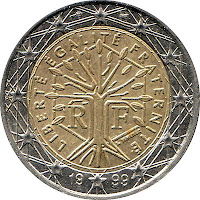 |
| Italy's 1-euro coin |
2012 marks the 10th anniversary of the coins and bills of the euro (which was first used in 1999 for electronic transactions between nations). The euro (always lowercase, like dollar or penny) is currently used by 17 countries in Europe:
- Austria
- Belgium
- Cyprus
- Estonia
- Finland
- France
- Germany
- Greece
- Ireland
- Italy
- Luxembourg
- Malta
- The Netherlands
- Portugal
- Slovakia
- Slovenia
- Spain
- Monaco (in France)
- San Marino (in Italy)
- Vatican City (in Italy)
Back in 2002, the first 15 European Union members to convert to the euro were: Austria, Belgium, Finland, France, Germany, Greece, Ireland, Italy, Luxembourg, Monaco, The Netherlands, Portugal, San Marino, Spain, and Vatican City. Slovenia switched to the euro in 2007, Malta and Cyprus in 2008, Slovakia in 2009, and Estonia in 2011. The European Central Bank has an interactive map showing the growth of the euro-using area.
The euro is worth the same amount in any of the above euro member countries (which are collectively referred to as the Eurozone). That means that if you live in France and travel to Spain, you don't have to exchange your French money for Spanish money. (Within the United States, we're quite familiar with this - if you travel from California to Florida, you don't have to change your money for "Florida dollars". US dollars can frequently be used outside of the States, but that's not the same as a currency union like the Eurozone.)
 |
| The reverse sides of the 8 standard euro coins |
- 1 cent
- 2 cents
- 5 cents
- 10 cents
- 20 cents
- 50 cents
- 1 euro
- 2 euros
Individual countries may mint commemorative coins larger than 2 euros, such as Portugal's 2.5-euro coins, Slovenia's 3-euro coins, and Germany's 10-euro silver coins. But these are generally only for collecting.
 |
| Euro 2-cent obverses (left to right): Italy, Spain, Ireland, Belgium, and France |
The 2-euro coins are frequently minted with special commemorative designs to honor a person, place, or event. The European Central Bank has pictures of the commemorative 2-euro coins issued by each country since 2004. Sometimes a single special 2-euro design is minted in all euro countries, such as 2012's "10 years of the euro" coin.
The backs (reverse) display the amount and are the same in all countries. The coins are also the same size and shape in all countries, so the only difference you'll see between an Austrian 1-euro coin and a Slovakian 1-euro coin is the design that is on the front.
 |
| Portugal's 5-cent coin |
